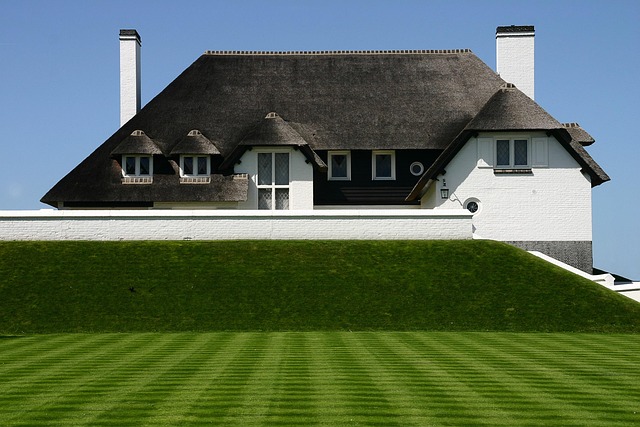This comprehensive guide covers the intricacies of flat roof installation and repair for both commercial and residential properties. It emphasizes selecting suitable materials like EPDM, TPO, modified bitumen, or PVC based on specific needs. The process includes meticulous preparation, application of membranes, sealing joints, and flashing around penetrations to ensure a waterproof barrier. Regular maintenance is crucial for extending the lifespan and preserving structural integrity. Flat roof specialists follow strict protocols from inspection to final testing, using high-quality materials and equipment. Maintenance involves cleaning, quick repairs, and reapplying coatings to keep roofs in optimal condition. Choosing durable materials and professional services ensures reliable, long-term solutions. SEO keywords like flat roof installation, repair, commercial/residential, and waterproof highlight key aspects for comprehensive flat roofing management.
Seamless installation of flat roofs is now a reality with the right expertise and materials. This comprehensive guide delves into the world of flat roof repair and installation, offering valuable insights for both commercial and residential properties. From understanding the basics to choosing durable roofing materials and maintaining your new flat roof, we provide step-by-step solutions. Discover expert tips from top flat roof specialists, ensuring you get long-lasting, waterproof flat roof services and solutions that stand the test of time.
- Understanding Flat Roof Installation: A Comprehensive Guide
- Choosing the Right Materials for Your Flat Roofing Project
- The Process: Step-by-Step Flat Roof Repair and Installation
- Maintaining Your Commercial or Residential Flat Roof: Tips and Best Practices
Understanding Flat Roof Installation: A Comprehensive Guide
Understanding Flat Roof Installation: A Comprehensive Guide
When it comes to flat roof installation or repair, whether for commercial or residential properties, choosing the right materials and employing expert specialists is paramount. Commercial flat roofing often demands robust, long-lasting solutions like EPDM (Ethylene Propylene Diene Monomer) or TPO (Thermoplastic Polyolefin) membranes, which offer superior durability and waterproofing. For residential flat roofs, materials like modified bitumen or PVC (Polyvinyl Chloride) are popular choices due to their affordability and ease of installation.
The process involves meticulous preparation of the roof deck, ensuring it’s clean, dry, and free from any defects. After selecting the appropriate roofing material, skilled installers layer the membrane, seal joints, and install flashing around penetrations like drains or vents, creating a seamless, waterproof barrier. Regular maintenance, including inspections and repairs, is crucial to prolonging the life of flat roofs, ensuring optimal performance and preventing costly damage.
Choosing the Right Materials for Your Flat Roofing Project
When embarking on a flat roofing project, be it for commercial or residential purposes, selecting the appropriate materials is paramount to ensuring long-lasting and durable results. The market offers an array of options tailored to different needs and climates. For instance, choosing between single-ply membranes, TPO (Thermoplastic Olefin), EPDM (Ethylene Propylene Diene Monomer), or rubber-based solutions depends on factors such as budget, building size, and local weather conditions. These materials boast exceptional waterproof properties, crucial for flat roofs that are vulnerable to leaks.
Commercial flat roofing often demands robust and low-maintenance solutions like modified bitumen or metal roofing systems. These materials provide superior strength and protection against extreme temperatures. In contrast, residential flat roofs may benefit from more aesthetically pleasing options like ceramic or slate tiles, offering both durability and a unique design element. Flat roof specialists emphasize the importance of regular maintenance and occasional repairs to prolong the life of these installations, ensuring they remain functional and safe for years to come.
The Process: Step-by-Step Flat Roof Repair and Installation
The process of installing or repairing a flat roof involves several precise steps to ensure a durable and waterproof finish. It begins with a thorough inspection of the existing roof, identifying any damage or areas requiring repair. Commercial or residential flat roofs alike demand careful attention to detail during this stage to prevent future leaks. Once repairs are made, using specialized tools and flat roofing materials like tarps, membranes, or single-ply sheets, the setup for the new flat roof begins.
Specialists in flat roof services will then prepare the surface, ensuring it’s clean and free from debris. This is a critical step to guarantee the longevity of the waterproof flat roof. Following preparation, the chosen flat roofing materials are meticulously installed, often with the aid of advanced equipment. The process culminates in rigorous testing to verify the integrity of the seal, ensuring every joint and corner is secure and leak-free. Regular maintenance and inspections further extend the life of these durable flat roofs, providing homeowners or business owners with a reliable and low-maintenance solution.
Maintaining Your Commercial or Residential Flat Roof: Tips and Best Practices
Maintaining a commercial or residential flat roof is crucial for ensuring its longevity and protecting your property from potential damage. Regular inspections are key; look for signs of wear, cracks, or leaks. Addressing issues early through flat roof repair can prevent more costly damages down the line.
Choosing the right flat roofing materials is also essential. Waterproof flat roofs, known for their durability, offer reliable protection against elements like rain and snow. Flat roof specialists recommend opting for high-quality materials and seeking professional flat roof services to ensure proper installation and maintenance. Regular flat roof maintenance involves cleaning gutters, repairing minor damages promptly, and reapplying coatings or sealants as needed. These practices contribute to the overall health of your flat roof, guaranteeing its performance and extending its lifespan.
Seamless installation and proper maintenance are key to ensuring the longevity and durability of both commercial and residential flat roofs. By understanding the process, choosing the right materials, and following best practices, you can achieve a robust, waterproof flat roof that stands the test of time. Flat roof specialists provide valuable insights and solutions tailored to your needs, making it easier than ever to access top-quality flat roof services and products. Regular maintenance, combined with expert knowledge, guarantees a safe, low-maintenance, and attractive roofing system for years to come.
